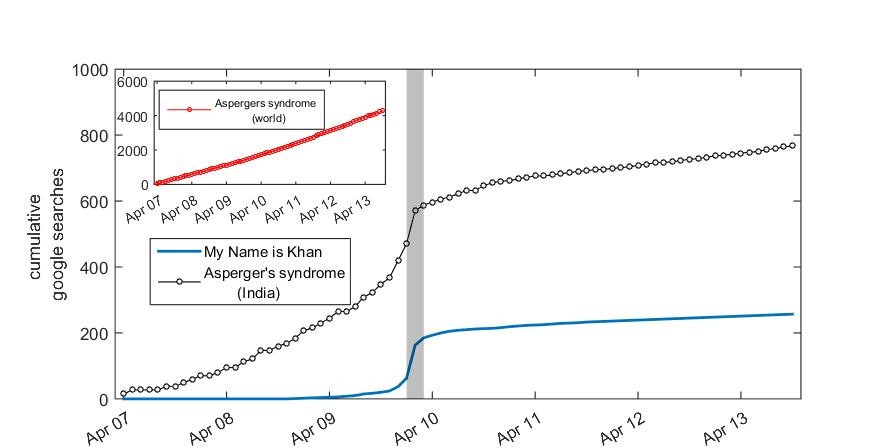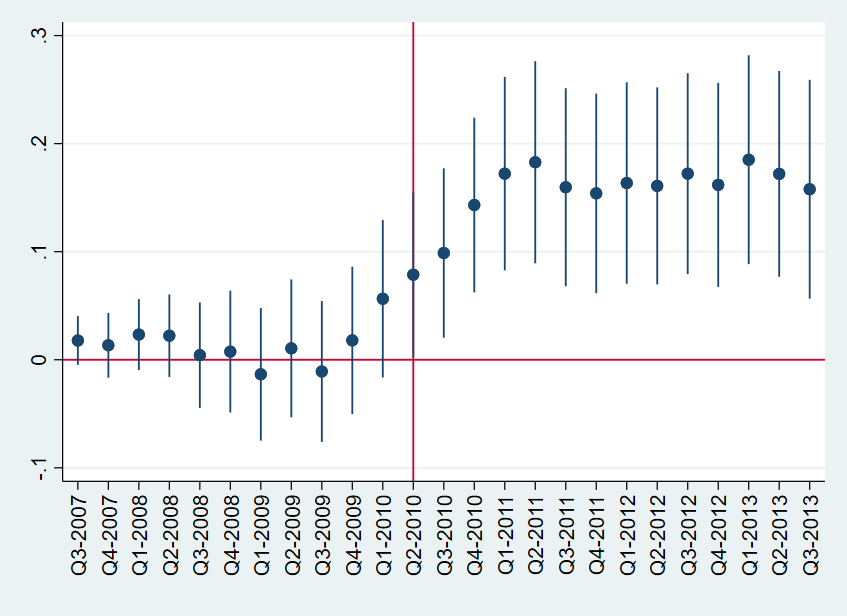Recently, educational entertainment has emerged as a platform for addressing public health issues. In this article, Aggarwal, Chakrabarti, and Chatterjee investigate whether movies can destigmatise accessing healthcare and increase consumer choice in the Indian pharmaceutical market. They explore the impact of the release of the Bollywood movie My Name is Khan on the market for antipsychotic drugs in India by analysing firm-level market responses, and find an increase in supply of drug varieties due to the destigmatisation caused by the movie.
Stigma in healthcare poses a major challenge, especially in low- and middle-income countries – it causes friction and there is reluctance from consumers to access the products, which also leads to a lack of supply-side incentives. Stigma creates a taboo and makes the market much more inefficient and affects conditions such as mental health, sexual health, and even vaccines. One mechanism that has been explored in recent years is using celebrity endorsement to destigmatise the market for vaccines (Alatas et al. 2019), sexual health (Banerjee et al. 2019), and even to promote testing – such as when Angelina Jolie was reported to have tested for the BRCA gene (Desai and Jena 2016).
In our study (Aggarwal, Chakrabarti, and Chatterjee 2023), we examine the firm response to destigmatisation because of the Bollywood movie My Name Is Khan, where the protagonist, Shahrukh Khan’s character, has Asperger’s Syndrome. The release of the movie led to destigmatisation of mental disorders, and we evaluate whether it concurrently led an increased variety of drugs sold specifically advanced antipsychotics.
The stigma around mental health
Stigma around accessing health services poses a special challenge for healthcare delivery. Stigma leads to inefficient matching, and customers, while being aware of the problem, do not seek care which creates an inadequate supply-side response. The problem is more severe for mental health (Patel et al. 2016) due to additional socioeconomic disparities and cultural factors. Exacerbated also by the lack of access to healthcare facilities for mental illnesses, estimates for the disease burden of mental health in India tend to be imprecise (Patel et al. 2016). Statistics from the National Mental Health Survey of India 2015-16 indicate that 150 million individuals need support for mental disorders in the country, but due to the stigma associated with mental illness, there is significant undertreatment.
Daley (2004) shows that while early diagnosis is necessary for effective treatment in the case of autism, it is not carried out in India due to a false belief that this is a transient phase, and the child will automatically heal with time. In addition, the prevalence of traditional medicines (such as homeopathy, Ayurveda, unani medicines, etc.) plays a significant role in the treatment process (Thirthalli et al. 2016), despite concerns about their efficacy and potential side effects. People with mental health problems in India also face exclusionary pressures from society (Mathias et al. 2015, Koschorke et al. 2017). These create significant barriers to addressing the problem of mental health in India.
Can movies lead to destigmatisation and change the supply-side response?
Celebrity-induced destigmatisation can lead to changes in attitudes and can ease friction in a variety of contexts. Media can also play an 'edu-tainment' role and influence beliefs, leading to a potential change in behaviour (La Ferrara et al. 2012).
Our research looks at the release of the movie My Name Is Khan (MNIK) and its impact on the supply-side. In this movie Shahrukh Khan essays the role of the protagonist Rizwan Khan, who is diagnosed with Asperger’s Syndrome and displays severe symptoms while working for his family. This movie is a potentially destigmatising event, leading to increased awareness about Asperger’s Syndrome and associated changes in behaviour.
Asperger’s Syndrome is managed through antipsychotic medicines, which can be divided into typical and atypical antipsychotics. Atypical antipsychotics are associated with fewer adverse events and are typically considered safer (Dolder et al. 2002, Jensen et al. 2007, LeClerc and Easley 2015). We hypothesise that with the movie’s release, there will be greater information diffusion among patients, which influences patient-physician interaction, potentially leading to an expansion in medicine choices available in the market (Białkowski and Clark 2022).
Methodology
We use two datasets to study the impact of MNIK on the supply of antipsychotic medicine: one is the All-India Organisation of Chemists and Druggists (AIOCD) Pharmatrac Database. This database captures sales data from retailers all over India and provides information about 60% of drug sales in India (Adbi et al. 2019). Two, to access the change in physician behaviour, we use the IQVIA prescription audit database, which draws on a sample of a million prescriptions monthly to provide information about physician prescribing behaviour (Dutta 2011, Duggan and Goyal 2016).
Key findings
To access the information diffusion around the MNIK release, we find a drastic increase in Google keyword searches for Asperger’s Syndrome post the release of the movie (Figure 1).
Figure 1. Patterns in Google keywords search

Notes: i) The figure presents cumulative searches for a) Asperger’s Syndrome and b) My Name is Khan, and compares Asperger’s Syndrome searches in India with global searches ii) The dark grey vertical line corresponds with the release of MNIK in February 2010
We also find an average increase in unique stock keeping units sold for atypical molecules of around 18% post the release of MNIK, and an increase at the prescription level of around 25% which provides initial support for our hypotheses.
We also analysed the impact of MNIK on the antipsychotic market using a difference-in-difference estimation1. We find strong evidence that before the release of MNIK, there was no substantial change in the variety of atypical versus typical molecules – however, post the release, there was a significant expansion in the choice of atypical molecules.
Figure 2 shows that there was no statistical difference in the variety of typical and atypical molecules before the release of MNIK; but post the release of the movie, we see a significant upward shift in the variety sold for atypical molecules compared to typical molecules.
Figure 2. Impact of MNIK on the variety of atypical molecules
Given the negative relationship between the treatment of mental health and income (Large et al. 2008), this increase in variety provides more options to patients and hence is welfare enhancing, especially due to the lower extrapyramidal side effects (such as involuntary facial movements or jerky limb movements) of atypical antipsychotics.
When we dig deeper into the data, we find that, generally, the increase in variety is higher for regions with higher literacy compared to ones with lower literacy, which corresponds to supply-side actions being motivated by consumers’ willingness to pay. We find further regional variations in the impact of MNIK on the market in southern India, where Hindi is not dominant as a language but where literacy and therefore willingness to pay might be higher than the rest of India. Since these states are considered to have higher levels of economic development, it is likely that firms would explore these markets by providing more variety in these regions. We also find expansion is much stronger in drugs that are not approved by the US Food and Drug Administration, hinting at the sub-optimum welfare effect.
Next, we checked the effect in our prescription data, and we found similar results. There is a 22% expansion in variety for average atypical molecules post the release of MNIK, hinting at a change in psychiatrist behaviour. Our results remain robust to pre-trends, synthetic control and sub-sample analysis.
Conclusion
Existing research has found evidence that increased choices can lead to welfare increases, such as increased access to buprenorphine leading to a 111% increase in physicians choosing it for opioid use disorders (Barnett et al. 2019). Increased information can lead to change in the intentions of both consumers and physicians (Kitchener and Jorn, 2002), and hence a change in the supply-side due to a movie release can potentially have significant welfare implications.
Significant friction exists in the mental health treatment market in emerging countries (Patel et al. 2016). While educational entertainment impacts preferences and can change behaviour – consider, for instance, the impact of soap operas on fertility (La Ferrara et al. 2012), and the impact of movies on nutritional habits (Banerjee et al. 2015) or even improving women’s status and information seeking behaviours (Jensen and Oster 2009) – our work provides evidence on how it can induce supply-side response in terms of more products and variety, and lead to potential welfare benefits.
Our results provide guidance to policymakers on where they can use edu-tainment to induce a supply-side response, which can eventually lead to a change in demand. Movies can thus serve as a low-cost intervention option that can be used to address stigma in healthcare settings.
Note:
- Differences-in-differences is a technique used to compare the evolution of outcomes over time in similar groups, where one was affected by an event – in this case, information diffusion after the release of My Name Is Khan – while the other was not.
Further Reading
- Adbi, Arzi, Chirantan Chatterjee, Matej Drev and Anant Mishra (2019), “When the Big One Came: A Natural Experiment on Demand Shock and Market Structure in India’s Influenza Vaccine Markets”, Production and Operations Management, 28(4): 810-832.
- Aggarwal, Mayank, Anindya S Chakrabarti and Chirantan Chatterjee (2023), "Movies, stigma and choice: Evidence from the pharmaceutical industry", Health Economics, 32: 1019-1039.
- Alatas, V, AG Chandrasekhar, M Mobius, BA Olken and C Paladines (2019), 'When Celebrities Speak: A Nationwide Twitter Experiment Promoting Vaccination In Indonesia', National Bureau of Economic Research Working Paper 25589.
- Banerjee, A, S Barnhardt and E Duflo (2015), 'Movies, Margins, and Marketing: Encouraging the Adoption of Iron-Fortified Salt', in DA Wise (ed.), Insights in the Economics of Aging.
- Banerjee, A, E La Ferrara and VH Orozco-Olvera (2019), '', National Bureau of Economic Research Working Paper 26096.
- Białkowski, Jedrzej and Jeremy Clark (2022), "The effects of drug safety warnings on drug sales and share prices", Health Economics, 31(1): 174–196.
- Daley, Tamara C (2004), “From Symptom Recognition to Diagnosis: Children with Autism in Urban India”, Social Science & Medicine, 58 (7): 1323-1335.
- Desai, Sunita and Anupam B Jena (2016), “Do Celebrity Endorsements Matter? Observational Study of BRCA Gene Testing and Mastectomy Rates after Angelina Jolie’s New York Times Editorial”, BMJ, 355: i6357.
- Dolder, Christian R, Jonathan P Lacro, Laura B Dunn and Dilip V Jeste (2002), “Antipsychotic Medication Adherence: Is There a Difference between Typical and Atypical Agents?”, American Journal of Psychiatry, 159(1): 103-108.
- Duggan, Mark, Craig Garthwaite and Aparajita Goyal (2016), "The Market Impacts of Pharmaceutical Product Patents in Developing Countries: Evidence from India", American Economic Review, 106(1): 99-135.
- Dutta, Antara (2011), "From free entry to patent protection: Welfare implications for the Indian pharmaceutical industry", The Review of Economics and Statistics, 93(1), 160-178.
- Jensen, Peter S, Jan Buitelaar, Gahan J Pandina, Carin Binder and Magali Haas (2007), “Management of Psychiatric Disorders in Children and Adolescents with Atypical Antipsychotics”, European Child & Adolescent Psychiatry, 16(2): 104-120.
- Jensen, Robert, and Emily Oster (2009), “The Power of TV: Cable Television and Women’s Status in India”, The Quarterly Journal of Economics, 124(3): 1057-1094.
- Koschorke, Mirja, et al. (2017), “Experiences of Stigma and Discrimination Faced by Family Caregivers of People with Schizophrenia in India”, Social Science & Medicine, 178: 66-77.
- La Ferrara, Eliana, Alberto Chong and Suzanne Duryea (2012), “Soap Operas and Fertility: Evidence from Brazil”, American Economic Journal: Applied Economics, 4(4): 1-31.
- LeClerc, Sheena and Deidra Easley (2015), “Pharmacological Therapies for Autism Spectrum Disorder: A Review”, Pharmacy and Therapeutics, 40(6): 389-397.
- Mathias, Kaaren, Michelle Kermode, Miguel San Sebastian, Mirja Koschorke and Isabel Goicolea (2015), “Under the Banyan Tree-Exclusion and Inclusion of People with Mental Disorders in Rural North India”, BMC Public Health, 15: 446.
- Patel, Vikram, et al. (2016), “The Magnitude of and Health System Responses to the Mental Health Treatment Gap in Adults in India and China”, The Lancet, 388(10063): 3074-3084.
- Thirthalli, Jagadisha, et al. (2016), “Traditional, Complementary, and Alternative Medicine Approaches to Mental Health Care and Psychological Wellbeing in India and China”, The Lancet Psychiatry, 3(7): 660-672.




 07 June, 2023
07 June, 2023 







Comments will be held for moderation. Your contact information will not be made public.